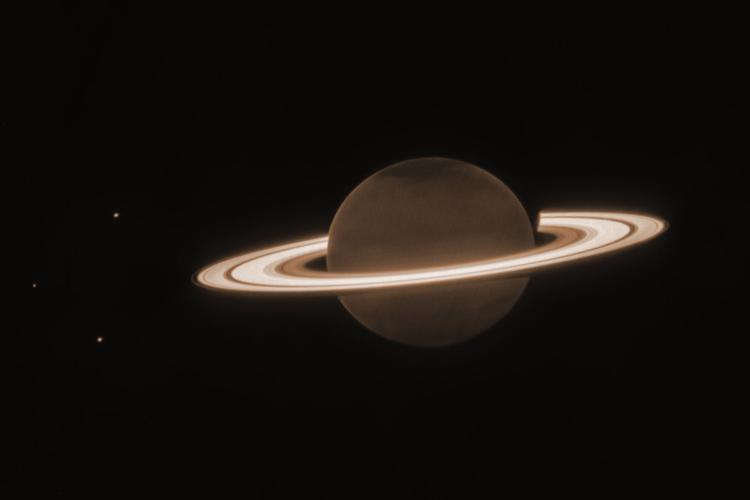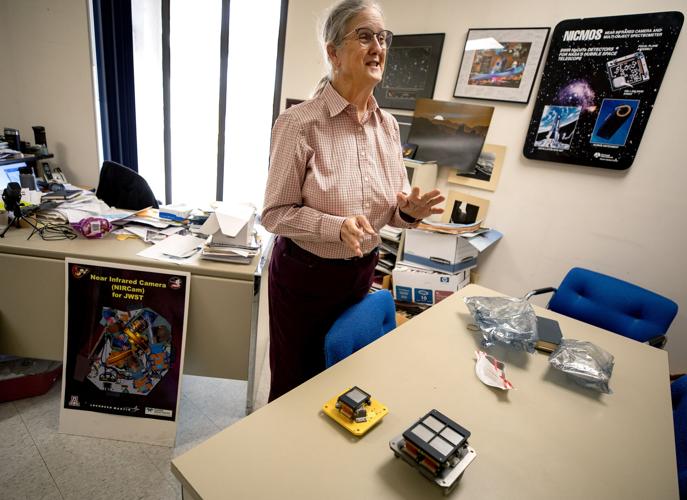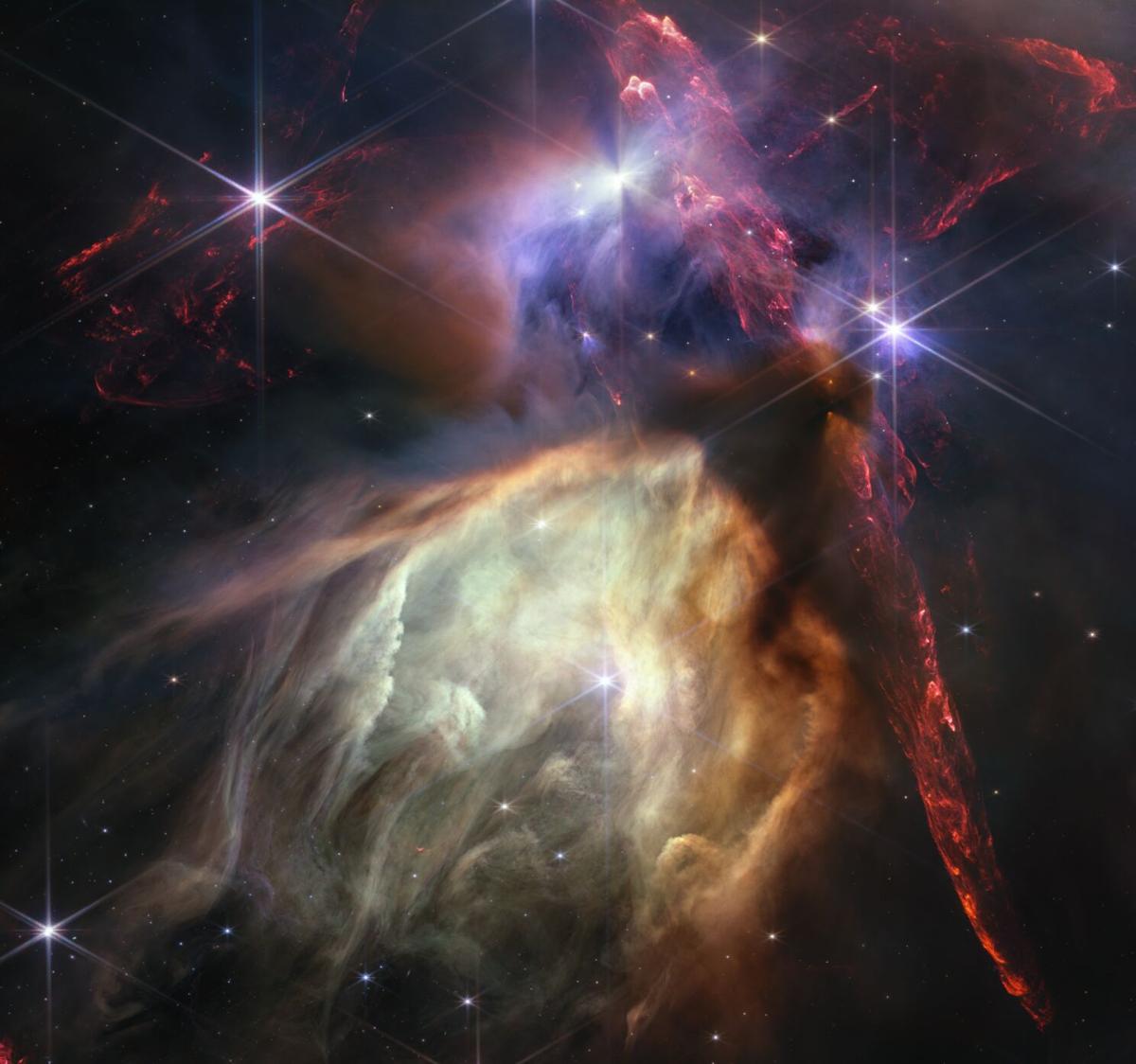NASA unveiled a stunning closeup of a stellar nursery on Wednesday to mark the first full year of scientific observations by the James Webb Space Telescope.
The $10 billion infrared observatory with deep roots in Tucson has already revealed the atmospheric composition of faraway planets and captured the most distant galaxies and supermassive black holes ever discovered.
Several dozen University of Arizona astronomers, engineers and students helped develop the telescope’s two main instruments: the Near Infrared Camera, or NIRCam, and the Mid-Infrared Instrument, or MIRI.
“Webb results so far have exceeded our expectations,” said UA Regents’ Professor Marcia Rieke, who led the NIRCam development team and now serves as its principal investigator. “We hope to find more surprises that get revealed due to Webb’s extraordinary image quality.”

The planet Saturn and three of its moons, from left, Enceladus, Tethys and Dione, captured by the James Webb Space Telescope this month. In infrared, the planet appears dark because sunlight is absorbed by methane in the atmosphere.
The picture revealed Wednesday features the Rho Ophiuchi cloud complex, the nearest star-forming region to Earth at roughly 390 light-years away.
The zoomed-in view shows approximately 50 young stars, most of them similar in mass to the Sun or smaller. Some of the stars already display the shadowy disks that mark the beginnings of future planetary systems.
As the new suns first burst through their natal envelopes of cosmic dust, they cast off bipolar jets of molecular hydrogen that glow red like embers.
Take a tour of Rho Ophiuchi, the closest star-forming region to Earth.
“Webb’s image of Rho Ophiuchi allows us to witness a very brief period in the stellar life cycle with new clarity,” said Klaus Pontoppidan, a Webb project scientist at the Space Telescope Science Institute in Baltimore, Maryland. “Our own sun experienced a phase like this, long ago, and now we have the technology to see the beginning of another’s star’s story.”
Orbiting around the sun about 1 million miles from Earth, Webb is the largest and most powerful astronomical observatory ever sent into space.

University of Arizona Professor of Astronomy and NIRCam Principal Investigator Marcia Rieke with replicas of the sensors in the NIRCam, the main camera on NASA's new James Webb Space Telescope. Rieke designed the NIRCam.
The bonanza of discovery during its first year in operation has produced hundreds of scientific papers, including some by University of Arizona researchers.
Late last month, for example, a team led by astronomers from the university announced they had teased out one of the oldest threads of the “cosmic web” that binds the universe together — a 3-million-light-year-long filament hung with galaxies and anchored by a quasar powered by an active, supermassive black hole.
“This is one of the earliest filamentary structures that people have ever found associated with a distant quasar,” said Feige Wang, an assistant research professor at the UA’s Steward Observatory and principal investigator for the team that made the discovery.
Their findings are documented in two papers published on June 29 in The Astrophysical Journal Letters.
This marks the first time such a cosmic filament has been observed at such an early time in the universe and in 3D detail — all thanks to Webb, said Wang, who served as lead author on one of the papers.
NASA released the new image of Rho Ophiuchi one year to the day after President Joe Biden, Vice President Kamala Harris and NASA Administrator Bill Nelson gathered at the White House to unveil one of Webb’s first triumphs: a deep-field image of impossibly far-off galaxies lighting up the early universe.
Rieke said the telescope she helped design has already spotted the most distant galaxy ever observed as it looked roughly 320 million years after the Big Bang, and she expects Webb to probe even closer to the beginnings of the universe.
“We hope to push another 100 million years back in time,” said Rieke, whose husband, fellow UA Regents’ Professor George Rieke, helped design MIRI and now leads that instrument’s science team.
NASA has allotted 13% of the space telescope’s total observing time to the UA, more than any other astronomy center in the world.
“In just one year, the James Webb Space Telescope has transformed humanity’s view of the cosmos, peering into dust clouds and seeing light from faraway corners of the universe for the very first time,” said NASA Administrator Nelson in a written statement. “Thousands of engineers, scientists, and leaders poured their life’s passion into this mission, and their efforts will continue to improve our understanding of the origins of the universe — and our place in it.”







